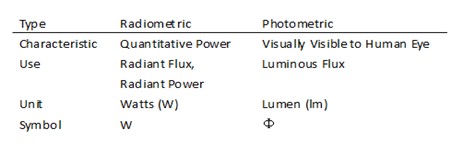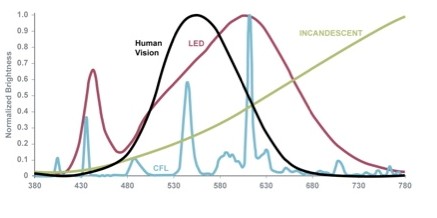By Scott Watson
Light that is visible to human eyes is simply electromagnetic waves whose wavelength which happens to be in the perceptible range. The unit that we used commonly to measure the energy of light is watts and the quantities we used to describe a light’s characteristics are radiometric. How light is perceived by each one of us is varied, our eyes and brain can give a different perception of a similar light‘s color and brightness. We, the human, are typically responding to light with wavelengths from 380 nm to 780 nm. After the light signal is picked up by our eyes, it gets pretty complicated after that, since we response differently depending on the relative conditions and personal choices. For this purpose, Photometric is a unit used to measure the volume of light being picked up by human eyes.
A light source’s emission spectrum is the key in description its characteristics. Light engineers should focus on the amount of light and color, and also apart from the emitter, how the light is being reflect and absorbed. Easily said, we must study and understand how the light is being perceived by end users.
A common LED product description we saw on the shelf is typically described by only lumens and color temperatures. However, when lights are used in an instrument machinery setting, the most important factor is its light intensity. To most common household, we care mostly about the light color rendered. As we proceed on, we will be discussing each characteristic in a clear, easy to understand level.
Light Emitted as Radiation
The energy of light emitted at different wavelengths is measured in the unit joules, the earlier mentioned watt is also connected, watts here measure the rate of how joules are consumed. In short this is what we called a radiometric quantity, the measurement of energy radiated per second.
Figure 1.1 Wavelength image from Universe by Freedman and Kaufmann.

Typically, light is referred by using their indicated wavelength. For example 650 nm light is a red light and a 470 nm light is a blue light. Without going into too much technical jargon, the shorter the wavelength the higher the energy gets. Blue light here has more energy than red light and ultraviolet and even X rays will have further more energy.
Monochromatic light mean the light is composed from one single frequency. Lights having this type of characteristics including laser or color filtered light. However, common light source and nature light source have a mix of wavelength and colors. The sun, for instance is a combination of various wavelengths and their power.
The difference between radiant power and radiant flux, radiant flux measures the total power radiated in all directions, regardless of the distance the measurement of total radiant flux remains the same, unlike radiant power which decreases as the distance increased.
Comparing Radiometric and Photometric
Now let us proceed on to discuss how light is perceived by the human eye. Since we only care how the light is perceived, after the quantity radiant flux is weighted by the spectral response of the human eyes, we have light measured in lumens (lm). All quantity of light weighted by the human eyes are of photometric quantities, this is quiet intuitive, just think the word “photo-metric”, the quantity of light that is in the visible range of our eyes. Thus, for every radiometric measure, there is equivalent measure in the unit of lumens.
Table 1.1 Comparing Radiometric and Photometric Light Power

The figure below shows us the range of visible wavelength to human eyes; the photometric quantities are weighed throughout the red light marked photopic (bright light vision), in comparison to the blue line, scotopic (night vision). You will notice the red line peaked at approximately 555nm, a yellowish green light. Human eyes are most sensible to this color, this is also why when using laser pointer, green laser produce a much more bright light than red laser at the same intensity.
On the other have, Scotopic curve also has a similar shape, but peaked at around 510nm, the color is pure green, with the peaked efficacy at 1700Lm/W compare to the 683Lm/W when under Photopic vision. This explains why the same wattage of light looks much brighter in a dark room than when in a lit room.
Figure 1.2 Scotopic Vision is much more Sensitive than Photopic Vision. Source: Kalloniatis and Luu (2007) .

Another lighting condition in between Scotopic and Photopic vision is mesoscopic vision. A good example of this kind of vision will be lights outdoor at night, while the setting is dark in general, but with lot of other light sources in the background or within certain distance. When picking and designing light sources for mesoscopic settings remember to adjust lighting levels accordingly in order to avoid picking lights that are either too bright or too weak for the purpose.
The conversion between radiant and luminous flux will be depended on the weighted wavelength spectrum of light. This being said that 1 W of green light at the peak of human eye response will be at 555nm and its luminous flux will be at 683lm as demonstrated in Figured 1.2. At the peak this is what we called a 100% conversion due to the fact that any other wavelength or color of light will convert to lower lumens.
Figure 1.3 Human Vision VS Emission Spectra of 3 Common Light Sources

If we take a look at figure 1.3, we can see that incandescent light is heavily weighted on the red side (longer wavelength side) into infrared ranges. CFL spikes unevenly begin at the edge of the ultraviolet range and then at every other phosphor wavelengths. LED on the other hand has a wider spectrum in the visible range. From the figure, we can easily see that incandescent light sources have the lowest conversion factor from radiant flux to luminous flux. This does make sense since incandescent light spectrum has the lowest match with the visible spectrum. Also, LEDs and CFLs are both about twice efficient and four times more efficacious due to the close match between human eye responses. Furthermore when comparing LEDs and CFLs, LEDs have a much wider spectrum match with human vision resulted in better color rendering ability.















